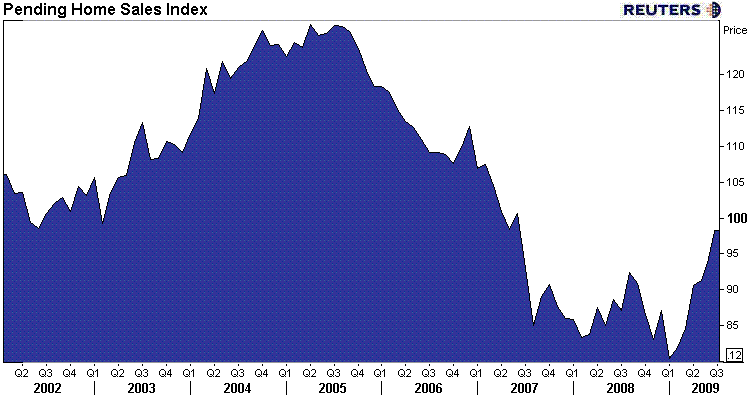A key housing report that anticipates future sales posted its sixth straight monthly gain in July. The Pending Home Sales Index jumped 3.2% in the month, doubling the consensus call for a 1.6% advance and providing optimism that the prime mover of the credit crisis ― housing ― is experiencing a broad leveling out.
“Do not underestimate this report, the great housing stabilization is firmly upon us within the residential housing market in the U.S.,” said TD strategist Ian Pollick.
Pending sales are contracts that have been signed but not finalized. Annually, they have jumped 12.9% since last year, compared with a +9.2% Y/Y print in June.

Regional data showed that the gains were lopsided, with the West posting a big 12.1% gain, followed by a 3.1% jump in the South. However, pending sales fell 2.4% in the Northeast and 1.8% in the Midwest. This continues the trend that the areas most disturbed by foreclosures continue to rebound at the fastest rate.
Still, Lawrence Yun, chief economist at the National Association of Realtors, who publish the report, called the recovery “broad-based across many parts of the country.”
As for the medium-term outlook, analysts at BMO Capital Markets pointed out that many of the factors helping housing now are temporary. They said the market was buoyed by “low mortgage rates, attractive pricing of distressed properties, some improvement in economic confidence, and the looming November 30 deadline to claim the first-time homebuyer tax credit.”
Once those factors are no longer at play, the housing market could suffer, especially as the unemployment rate is expected to hit 10% in early 2010.
Yun said as much in today’s press release: “Unless the tax credit is extended, no one should be surprised to see home sales drop in the first quarter of next year,” he said.
Released at the same time as the Pending Home Sales Index was a positive report from the nationwide ISM survey of manufacturing conditions, which posted its first sign of growth in 19 months.
Equities jumped at much as 1.25% in the aftermath of the two reports, yet one hour later stock markets had returned to flat levels.







